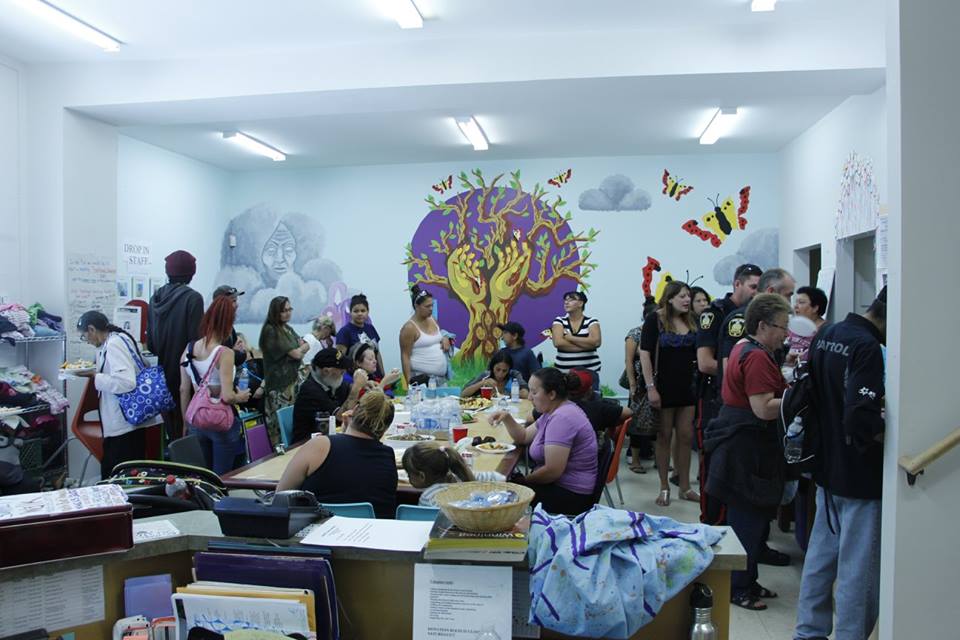On Friday May 26, I attended an impromptu event organized by supporters of the North Point Douglas Women’s Centre. The event was held to show support for the Centre, which was reeling from the news that it would not receive an expected $120,000 required for its operations. This represents one third of the Centre’s budget and losing it means that North Point Douglas Women’s Centre will be forced to cut important programs that are serving the community well. It got me thinking about reconciliation.
Indigenous women spoke passionately about the important role the Centre plays in their lives. They spoke about the culturally based programs that are helping them to heal from intergenerational trauma caused by government policies and programs like residential schools. As I listened to these women, it became clear that the Provincial government’s decision to cut funding for this and other community based programs serving high numbers of Indigenous peoples, is inconsistent with the Truth and Reconciliation Commission’s 94 calls to action and Manitoba’s Path to Reconciliation Act.
The Path to Reconciliation Act defines reconciliation as “the ongoing process of establishing and maintaining mutually respectful relationships between Indigenous and non-Indigenous peoples in order to build trust, affirm historical agreements, address healing and create a more equitable and inclusive society.” Among other things, it requires the minister responsible to develop a strategy for reconciliation that “builds upon meaningful engagement with Indigenous nations and Indigenous peoples…”
I wondered, what the strategy was? Did Minister Clarke consult with Indigenous women in North Point Douglas before cutting funding to their Centre? Did the minister consult with the many Indigenous women who use the services of the North End Women’s Centre, which has also been informed that it will receive less funding this year? And what about the many other services that have lost funding, or are waiting to hear of their fate, but are too nervous to talk about it? Most if not all of these organizations employ Indigenous people and serve large numbers of Indigenous people.
The Path to Reconciliation Act was introduced by the outgoing NDP government; it was given Royal Assent on March 15, 2016. On June 2nd, 2016 Eileen Clarke, the Minister of Indigenous and Municipal Relations addressed the House of Commons to acknowledge the one-year anniversary of the release of the Truth and Reconciliation Commission of Canada’s executive summary and 94 calls to action. Clarke also reported to the House that the Pallister government, through the Department of Indigenous and Municipal Relations, would “proceed with work to implement the Path to Reconciliation Act.”
The Act requires the government to appoint a minister responsible for developing a strategy that “builds upon meaningful engagement with Indigenous nations and Indigenous peoples,” creates a framework to advance reconciliation; establishes immediate and long-term actions that are responsive to “priorities and needs” of Indigenous nations and peoples, including those set out in the calls to action of the Truth and Reconciliation Commission”; and “fosters the involvement of all sectors of society in the reconciliation process” and establishes transparent mechanisms to monitor and evaluate measures taken…”
Although light on detail, the minister tabled a report on the Governments action to date in July 2016. Minister Clarke stated she looks forward to continued engagement of “all stakeholders to promote initiatives to advance reconciliation across all sectors of our society and continue to recognize the contributions of Indigenous peoples to the founding of Manitoba.”
As the minister responsible for Indigenous relations and the Path to Reconciliation Act, Ms. Clarke will know that a critical component of reconciliation is to close the gaps between Indigenous and non-Indigenous communities. The TRC Commission Report outlines clearly what needs to be done.
In urban centres, the gaps between Indigenous and non-Indigenous people is most notable in inner city and north end neighbourhoods where high numbers of indigenous people live. For example, upward of 40 per cent of North Point Douglas residents identified as “Aboriginal” in the 2011 census — almost 4 times that of the City of Winnipeg. Fully 20 per cent of inner city residents are Indigenous and a high proportion live in poverty.
While addressing the 94 calls to action will require a far more grand response than funding small organizations, these non-profits can and do provide one means by which non-Indigenous people can support reconciliation through our tax dollars.
The Pallister government keeps telling us we need to balance our books so that he can fulfill his promise to cut the PST. We need “all hands on deck” he tells us.
At a time when we are beginning to recognize the damages we have done, it is simply not okay to cut funding to organizations that are doing the important work that needs doing — work that is needed because of deeply damaging government policies. This is not a “path to reconciliation.”
Where to from here?
It is hard to know how the Pallister government plans to address the requirements of the Path to Reconciliation Act. Among other things, the Act requires the minister responsible to “make recommendations to the government on financial priorities and resource allocation across the government in relation to reconciliation.” In doing so, she/he must remember the high number of Indigenous people who continue to live in poverty in urban centres. In the spirit of reconciliation — in respect of the Act — they should be consulted.
This month Premier Pallister rode his bike to Peguis First Nation to honour 200 years of the Selkirk Treaty as “a gesture of reconciliation.” This gesture will remain hollow, even insulting when stacked next to the funding cuts. The Premier needs to move beyond gestures and take action to fulfill his government’s obligations as outlined in the Path to Reconciliation Act.
This piece originally appeared on the CCPA Manitoba’s PolicyFix blog.
Image: North Point Douglas Women’s Centre



